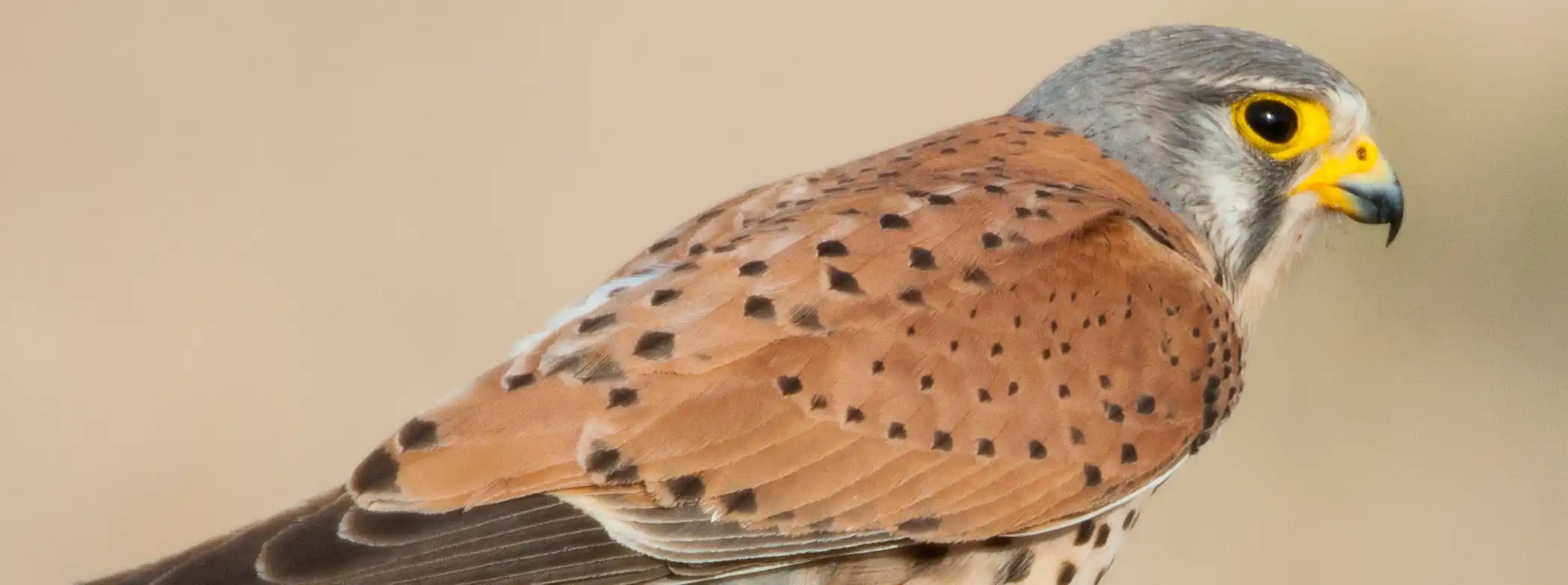
Our most familiar and common falcon, the Kestrel can be seen hovering over roadside verges. It is the only commonly occurring falcon in Britain that habitually hovers, although Lesser Kestrel and Red-footed Falcon in Europe also use this hunting technique. Buzzard and Rough-legged Buzzard also habitually hover.
Key facts
Common name: Kestrel
Scientific name: Falco tinnunculus
Habitat: Open country, urban areas, farmland, large gardens, open heathland, moorland and upland areas
Diet: Small mammals such as voles and young rats
Size: Average 34 cm, wingspan 76cm. Females (220g) larger than males (190g)
Status: Resident breeder. Passage/winter visitor
Population size: 31,000 pairs
Conservation status: AMBER (Due to recent breeding population decline)
Appearance
Kestrels are a small falcon which can be identified by their pointed wings and long tail, which is fanned out when hovering. Their tails have a distinctive black band across it. They are brown in colour with pale undersides with black speckles. The females are browner in colour with barring, while the males have a grey head and tail with just a single band across it. Both the male and female have distinctive dark markings below their eyes.
Lifespan
The average age in the wild is 4 years. Adults have a 69% year-to-year survival. First year survival is 32%. The oldest known wild bird was almost 16 years old (ringing recovery).
Nesting
Unusual among British birds of prey, Kestrel is a cavity nester, preferring holes in cliffs, trees or buildings. They can be found nesting inside industrial structures and readily take to nest boxes. Kestrels are remarkably tolerant of other near-by Kestrels and may nest semi-colonially in areas of high numbers. Only the female incubates the eggs, but both birds brood and provision the young.
Number of eggs: 4-5
Incubation: 28-29 days
Fledging time: 32-37 days
Habitat and Distribution
Kestrels are familiar and widespread, only absent from areas in the most extreme north and west of the country. Although birds of fairly open country, they adapt well to a range of habitats and can be found in urban areas, farmland and even large gardens as well as open heathland, moorland and upland areas.
Movements
Most British Kestrels are fairly sedentary, with some 75% not moving more than 70km from their natal area. As with most birds of prey, however, young birds may travel more widely before settling to breed. Kestrels can easily travel over open water and regularly cross the North Sea. Many Scandinavian birds, escaping harsh winters, will winter in the UK. Our Kestrel, known elsewhere in its range as Common Kestrel, is one of a group of similar species many of which are extremely range-restricted island species.
Feeding
Kestrels feed almost exclusively on small mouse-sized mammals. Voles are a favourite, although in certain areas young rats may be an important food source exposing Kestrels to commercial rodent poisons. Kestrels are, however, very adaptable birds and will make use of any opportunities as they arrive, including taking birds, especially nestlings, invertebrates, bats, reptiles and amphibians but they lack the agility to be especially good predators of birds, unlike the other falcons Merlin, Peregrine and Hobby. Each Kestrel requires the equivalent of 4-8 voles a day.
It is believed that hovering birds are watching for movement, regardless of how much the body moves, the head remains remarkably still while the bird is concentrating on the ground. It is now known that vole urine (which is constantly dribbled as the animal goes about its life) fluoresces and Kestrels can see the urine trails in the grass, leading them with a ‘road map’ to where the animal currently is.
Despite the classic hovering hunting method being so well-known, Kestrels prefer to employ the sit and wait approach to hunting, spending long periods sitting still on a post, tree or rock, watching until some item of prey is spotted, when the bird will slip off to pounce. In fact, hovering could be considered a sit and wait hunting technique where there is no suitable perch to use.

